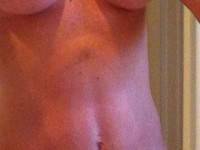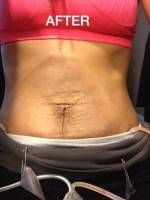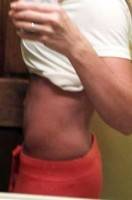Tummy Tuck Muscles
Muscle plication during abdominoplasties.
It will make a difference if you do not do the muscle plication your abdomen will not be as flat nor as tight.
If a person had several pregnancies the muscle certainly has separated to some degree and it is difficult to tell by physical exam sometimes. (Walter D. Gracia, MD, Arlington Plastic Surgeon)
Muscle Tightening with Tummy Tuck
I have never seen anyone having a tummy tuck who did not need a “muscle” tightening. Although you say your muscles are close together with flexing, they are not that way when your muscles are relaxed.
The fascia (the tissue that holds everything together) stretches with time and, especially, with pregnancy. We tighten this fascia to keep the muscles in normal position even when your muscles are not flexing. (Robert T. Buchanan, MD, Highlands Plastic Surgeon)
Muscle tightening during tummy tuck
Four pregnancies will usually result in some degree of muscle laxity which would benefit from abdominal wall muscle tightening. Although not severe, your photos confirm this and adding a muscle plication would most likely enhance your result. (David A. Bottger, MD, Philadelphia Plastic Surgeon)
Muscles Should Almost Always Be Plicated During Tummy Tuck
There are some circumstances in which the rectus muscles do not need to be plicated or tightened during a tummy tuck, but they are rare and you should have this as part of your tummy tuck.
Any woman, such as you, who has had 4 pregnancies will benefit from a muscle plication. I have seen a few patients, mainly those without pregnancies, who do not need a plication. (John Whitt, MD, Louisville Plastic Surgeon)
There is no right answer to muscle tightening during tummy tuck
In general most women who have delivered babies will have some element of diastasis of the rectus muscles. That being said the decision to tighten the muscle fascia is a clinical one based on what is seen on examination and during the surgery.
Often times I tighten the muscle fascia to narrow the waist and to get a more pleasing hour glass shape. You should trust your board certified plastic surgeon and discuss your concerns with him or her. (Dev Wali, MD, Claremont Plastic Surgeon)
Fascial Plication During Abdominoplasty
Body contouring operations are very patient specific. With respect to abdominoplasty, the amount of fascial plication varies depending upon individual needs. The amount of separation between the rectus muscles may vary significantly between women; but usually the more separation that is present between the muscles, the more the abdominal wall protrudes in the standing position.
Your pictures show that you have been much luckier than some women, and have not developed the degree of musculofascial looseness that many would after having four children.
However, it is still evident from your pictures that you have some looseness in the muscle and fascia of your abdomen – even if your muscles are not separated in the midline. So I believe that you need to have a plication performed with your abdominoplasty.
Fascial plication will definitely improve your result, and it is the only way to achieve a flatter, tighter abdomen. This plication will increase post-operative pain and prolong your return to strenuous activity, but it will make your abdominoplasty more complete.
Speak with your surgeon about your concerns so that both of you can reach a conclusion about how to best address this situation before surgery. (Kenneth Dembny, II, MD, Milwaukee Plastic Surgeon)
Tummy tuck muscles repair after multiple pregnancy
During tummy tuck muscle repair is a rather easy step and it is hard to imagine after four pregnancies that you would not benefit. The fact that you can place a finger between the sit-up muscles confirms the separation of the muscles or diastasis. Before pregnancy I doubt that you could do that. Certainly every tummy tuck should be individualized, but don’t let the recovery dissuade you from the best result. (Peter E. Johnson, MD, Chicago Plastic Surgeon)
Muscle repair during tummy tuck
Procedures should be tailored to individual patients. During surgery with muscle relaxation, additional laxity may be apparent that is not appreciated during an office visit exam. If there is no laxity when you are under anesthesia, there is nothing to be gained by tightening the muscles further.
Muscle tightening (“fascial plication”) is the major cause of post-operative discomfort during a tummy tuck, plays the greatest role in post-operative activity restrictions, and can potentially contribute to other post-operative complications as well. Performing a plication just to say that it was done does not make much sense, but communicate with your surgeon that if your abdominal wall appears lax under anesthesia and muscle relaxation, you would like to have the “muscles tightened”. My response to your question/post does not represent formal medical advice or constitute a doctor patient relationship. You should continue to follow-up with your plastic surgeon in order to receive formal evaluations and maintain your doctor patient relationship. (Craig S. Rock, MD, Houston Plastic Surgeon)
I almost always tighten the muscles. There are some rare times I don’t, but most of the time the result is improved by fixing the diastasis of the recti muscles (William B. Rosenblatt, MD, New York Plastic Surgeon)
Should muscles always be tightened in tummy tuck?
I agree that after 4 pregnancies, there may well be some laxity in your abdominal muscles. However, I do not always tighten the muscles. If there is no obvious stretch between the muscles when you flex them, then I make an assessment on the table, and only if there was a space between them, would I suture them back. No intervention is without complications and it does make it a little bit more uncomfortable when the muscles are repaired. (Jonathan J. Staiano, FRCS (Plast), Birmingham Plastic Surgeon)












